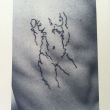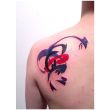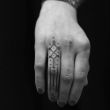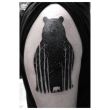If you have one hour, six minutes, and 53 seconds to listen to a good podcast episode, stop reading after the conclusion of this paragraph. “ Tattoos: Not Just For Dirtbags Anymore,” is the title of such a 'sode, from the not only informative, but interesting Stuff You Should Know 'cast, and everything below this shall henceforth be considered a spoiler. A few fun tattoo-related facts:
History
- Ötzi (also known as “The Iceman'), the oldest known preserved human body, has tattoos. Because there was joint disease found underneath each of his tattoos, it is thought that his ancient civilization believed the marks would relieve pain.
-It's believed that the word “tattoo' comes from the onomatopoetic Polynesian word, “tatau,” which means, “to strike.”
-Sailors—or the men who explored the South Pacific by ship—were the first Westerners to have tattoos. Since sailors were not necessarily considered upstanding citizens, the practice almost immediately became associated with counter culture.
-In a strange turn of events, during the Edwardian era, the society's elite began adopting tattoos as a sort of status symbol, largely due to the opening of the West to Japan and their extremely talented tattoo artists.
-The 1891 invention of the tattoo gun made getting a tattoo more accessible, and thus made the art form less appealing to the upper class.
-Martin Hildebrandt opened the first US tattoo shop in 1846 in NYC (we’re so cool), marketing to mainly members of the military.
-After the highly publicized Lindbergh kidnapping of 1932, Americans began tattooing their children with their Social Security Numbers.
-Tattoo parlors in NYC were banned between 1961 and 1997 (maybe we’re not so cool), and were illegal in Massachusetts until 2000.
Technique
-Tattoos are created by piercing through your epidermis (which you shed) into your more permanent dermis.
-The needle on a tattoo gun bobs, like a sewing machine, between 50 to 3,000 times per minute.
-Prison tattoos, however, a typically done with things like a staple or a guitar string attached to a toothbrush and dipped into pen ink, burnt shoe polish, or melted Styrofoam or plastic.
-Blue and black ink are the easiest to remove, while green is the hardest.
Safety
-Blood born pathogens are a serious concern when getting a tattoo—going to a highly trusted shop is always the best bet. That said, if the shop is following the three-pronged safety approach (more or less the same as any hospital or medical center), there is a very low chance of any disease transmission.
-According to the CDC, there have been zero reported cases of HIV transmitted via tattoo.
-Tattoos done as permanent makeup—like perma-eyeliner or perma-eyebrows—are frequently done with metallic pigment, which can cause issues with brain MRIs.
-In most circumstances, the American Red Cross will not accept blood donations from people who have gotten a tattoo within the past year.
Statistics
-In the US, the average cost of a small tattoo is $45.
-Approximately $1.6 billion is spent in the United States on tattoos every year.
-14% of all Americans have one or more tattoo.
-40% of 26-40 year old Americans have one or more tattoo.
-There are around 21,000 tattoo parlors in the US.
-17% of tattooed Americans regret getting one, 11% of tattooed Americans have theirs removed.
















































































